Keep your enemies close. Depending on how you spend your time, you’ve probably picked this up from Machiavelli, Petrarch, or Michael Corleone in the Godfather II. Regardless of the source, there’s a reason the saying has stuck. If you don’t know what your enemies—or business competitors—are doing, you’re only fighting half the battle. And that’s where competitor analysis and insight comes in.
Even if you don’t think of competitors as enemies, it’s important to know what they’re up to—and you get to that through deep competitive analysis. Let’s think of it as “spying for good reason”.
Competitive analysis gives you a benchmark of what’s working in the industry and what’s not. It highlights where the market is saturated, and where there’s room for your company to grow. It can bring to light marketing opportunities you’d otherwise miss.
Look at it this way: You probably wouldn’t enter a fitness competition without looking at pictures of past winners or researching their average body fat percentages. Otherwise, you could suffer through six months of sore muscles, salad, and bland chicken for nothing. You wouldn’t sell your old iPhone on eBay without checking the average price of identical models in similar condition.
The same logic applies when developing your content marketing strategy. Before you put information out there, it’s smart to know what you’re up against. Competitive analysis and insight help determine whether your strategy is the right one, rather than a shot in the dark. The result? Content marketing that resonates with customers, boosts your brand and drives sales.
We’ll dive deeper into exactly why competitive analysis is so important. But first, let’s define it in more detail.
What is Competitive Analysis?
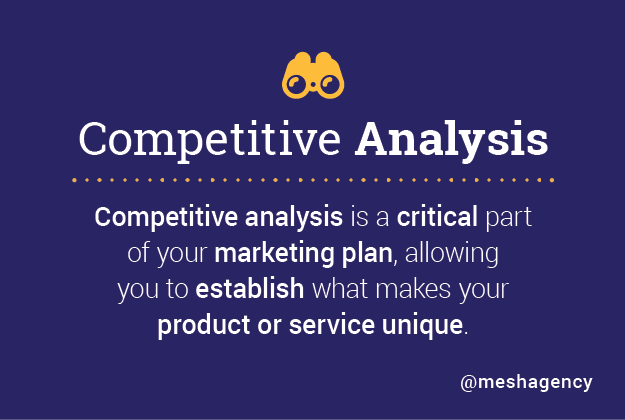
Entrepreneur describes competitive analysis as “identifying your competitors and evaluating their strategies to determine their strengths and weaknesses relative to your own product or service.” Competitive analysis is a critical part of your marketing plan, allowing you to establish what makes your product or service unique, as well as what attributes you should play up to attract your target market.
More dramatically, Harvard Business Review likens competitive analysis to equipping for battle. Surviving, thriving, and winning depend on your preparedness and what you know about the opponent:
“Effective marketing must involve a thorough analysis of the overall competitive arena and the competitors that battle within it. Competitive analysis determines whether firms decide to fight head-on with like products or maneuver a sneak attack with differentiation.”
Competitive analysis begins with research. Before you develop a content marketing plan, it involves finding out who your competitors are, what products or services they offer, examining their content marketing strategies, familiarizing yourself with their content and more.
A deep dive of a competitor’s content marketing initiatives should involve finding out:
- What topics, or “content entities”, your competitors are focusing on creating?
- What types of content they’re producing (i.e. blogs, white papers, case studies)?
- Where content lives on their websites – is it easy to find?
- How content is promoted and through which channels (socials, email blasts, newsletters, etc.)?
- Where does it rank in search engine traffic?
- How customers respond to content (shares, likes, comments)?
The next step is analyzing that research by evaluating the quality of your rivals’ content. You can have all the information in the world about competitors, but it’s useless until you put it to work.
Look at where your competitors are succeeding and where they’re falling short. What types of content are they failing to produce that you can? Where can you do better, providing richer and more helpful content? How can you do a better job of promoting that content?
HubSpot compiled a great list of questions to ask yourself when you’re evaluating content:
- How accurate is the content?
- Are there spelling and grammatical errors?
- How in-depth is the content – does it scratch the surface, or does it delve into advanced concepts?
- What tone is used?
- Is the content too long or short?
- Is the content reader friendly? Are they taking advantage of bullets, bold headings, white space, and numbered lists?
- Who is writing the content? Are they all internal, or are some guest contributors? What are the writers’ areas of expertise?
- Is the content mostly free, gated, or a mix of the two? What types of content ask readers to provide contact information for access?
Competitive analysis requires time and effort, no doubt, but the amount varies from one company to the next. There’s no standard formula; the analysis can be as comprehensive or as simple as it needs to be. If you’re in a highly saturated market, the investigation might have to be deep and thorough to make sure your content stands out. However, if you’re launching a new product in a market that is largely untapped, just a little competitive analysis will go a long way.
We prefer to analyze at least 30 – 40 pieces of content. Typically organizations are creating content around 7 – 10 main topics, focusing on a handful of content entities in an effort to be relevant, and rank with Google.
Why do you Need Competitor Analysis?
Competitor analysis tells you who your customers are, what they need and what challenges they face. This information is critical to creating content that educates, solves problems, and speaks to customers in a way that is timely, relevant, and relatable. Going one step further, analysis tells you what content to create, and why to create it.
Let’s say your marketing for a network cyber security firm that builds advanced firewalls for large corporations. You know from the sales team that customers are always asking for advice on regulatory compliance. You realize after some digging that competitor after competitor has blogged about ‘the five biggest compliance headaches’ but you don’t find any comprehensive list of security laws regulations, guidelines and best-practice solutions broken down by industry. There’s your first piece of content.
Or, maybe you’re a factory that specializes in producing allergy-free foods. You know customers often have a hard time locating factories that are best-suited to meet their strict manufacturing specifications – the process is long and painful. You scour competitors’ websites and find basic tips and general information on ‘finding the right factory’ but you don’t find a comprehensive checklist that walks clients through every stage of the process. There’s your opening. You create a five-page whitepaper that serves as a step-by-step guide to getting an allergy-free food product to market in half the time.
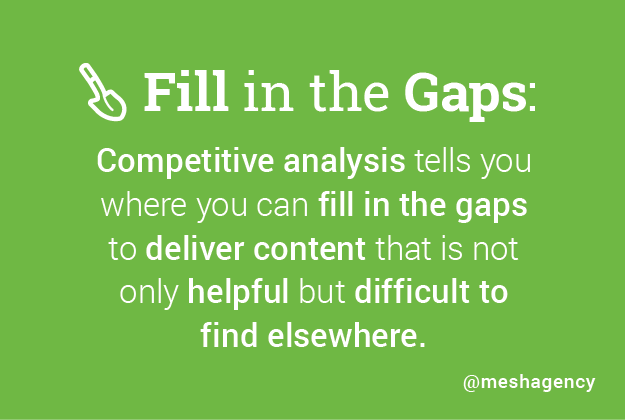
As Smart Insights accurately describes it, the insight you glean from what competitors, both direct and indirect, are doing allows you to build a picture of the type of content, strategies, and tactics that are working for others in your industry and what, as a result, might work best for you. More specifically, competitive analysis tells you:
- The content types and ideas getting the most traction, as measured by the number of shares or backlinks
- Contents gaps in your marketing plan compared to competitors
- Competitor strengths and weaknesses, as well as opportunities or threats from the wider market
Why is Insight Important?
Although the terms competitive analysis and competitive insight are often used together, they’re not the same. They’re related, but not interchangeable.
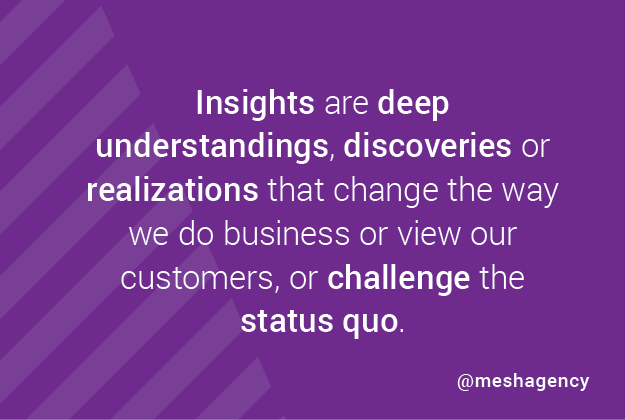
As Google puts it, insights are the basis on which great campaigns are built. Great creative work comes from great insights.
How to Conduct a Competitive Analysis
Again, there’s no one-size-fits-all formula here. But there are some best practices, as well as can’t-miss steps. Our process, which analyzes one competitor at a time, goes something like this:
- Identify the competitor to analyze
- Examine statements and claims – what are the company’s value propositions?
- Look at key product or service attributes.
- Evaluate the company’s credibility. Take a look at testimonials, client lists, satisfaction guarantees, awards, and samples.
- Consider the unique benefits the company offers. What can they do that no one else in the space can?
- Find out how the product or service is promoted. Which channels or strategies are used – social media, paid searches, newsletters, email blasts, etc.
- How much does the product or service cost?
- What kinds of offers are available to customers? How does the company use discounts, promotions, and calls to action?
- Content audit: gather, review, and analyze your competitor’s content—what are they focusing on, where are there gaps and opportunities for your content?
The final step is summarizing all those findings to analyze content marketing strengths and weaknesses. For example, where is their content focus? What content entities do they develop? What was particularly good or bad about the company’s calls to action? Does the company effectively use channels like search and social media? How user-friendly is the website, and is it easy to navigate?
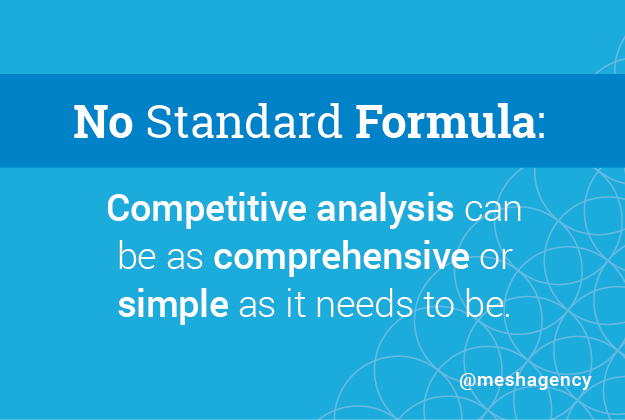
The Best Tools for Competitor Analysis
Technology can help with the legwork, speeding the process of finding good data. There are tons of great tools to help you build a successful content marketing strategy. Among our favorites:
Alexa is a powerful analytical tool digital marketers and content strategists use to gauge performance against the competition. Alexa helps you develop buyer personas by providing useful feedback about your market, including demographic information, user behavior data, and trends.
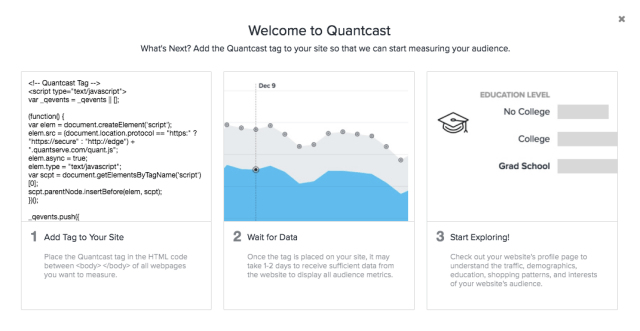
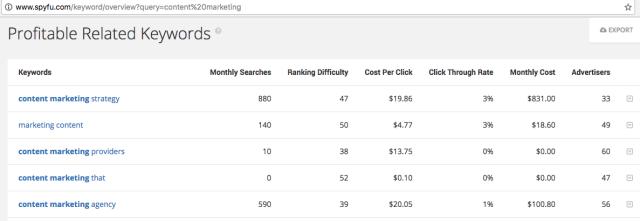
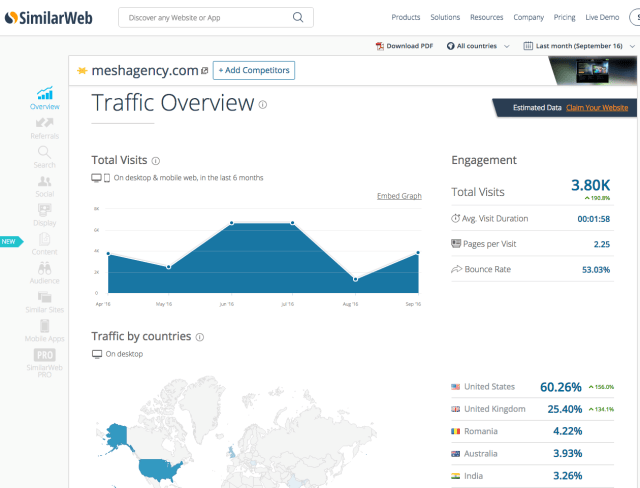
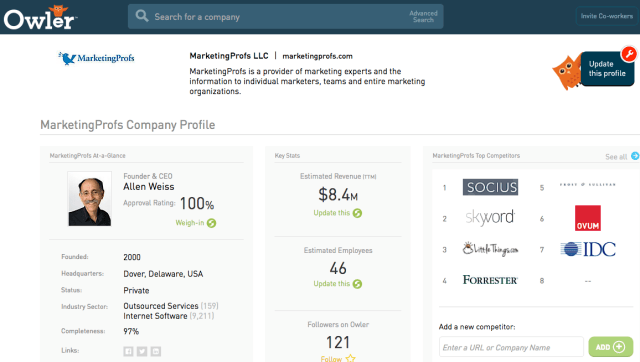

If you already have a content marketing strategy but need to improve traffic, consider QuickSprout. The tool offers insight into the competition’s content, including estimated traffic, SEO scores, and social shares. It also promises to deliver “wallet-out, read to buy” visitors.
Lastly, MESH is the first (and as of the writing of this post, currently ONLY) digital marketing agency that leverages AI to research, analyze your competitors’ content, industry subject matter, and drive strategic development of your content entities.
Of course, these tools only provide a starting point. It’s up to you to decide what to do with this new-found power—and all this data. The more effort you dedicate to analyzing the research to gain insights and perspective about your competitors and your industry, the stronger your content will be.
Have you conducted a comprehensive competitive analysis of your content? Were you able to identify content creation opportunities? What were some of the challenges you faced, and how did you overcome them?




